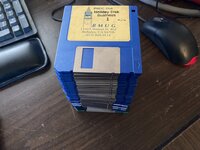You are using an out of date browser. It may not display this or other websites correctly.
You should upgrade or use an alternative browser.
You should upgrade or use an alternative browser.
Original BMUG Disks
- Thread starter olePigeon
- Start date
Scott Squires
Well-known member
Nice find! The CDs would usually contain the latest versions of software, and also wouldn't necessarily include older obsolete items. (Especially since at least some of these are 400k disks -- it was unusual for CD compilations to include 128k/512k software.) So would definitely like to see these imaged.
MacKilRoy
Well-known member
Unfortunately the disks have mold in them and it gummed up my floppy drive with the first disk. I'm 3D printing a gadget that should help me clean them. I'm just hoping I didn't irreparably damage my LC's floppy drive.
That's terrible! I often worry about that when getting floppy disks.
I do have a few of the BMUG CD-ROM collections that they published. I'll have to see about uploading them to the Macintosh Garden.
olePigeon
Well-known member
As far as I can tell, all of these disks are completely fubar. They permanently took down 2 of my floppy drives, even after I thoroughly cleaned the disks. Literally brought the two drives to a screeching halt. I was able to get one of the drives to work again after liberal cleaning of the heads. Tested it with known working disks. Worked fine. Decided to give one more disk a try after a nice clean, and ... screeeeeeeeeeech plop.  No amount of cleaning the heads has brought back those two drives.
No amount of cleaning the heads has brought back those two drives.
So I'm not going to risk trying any more of these disks, unfortunately.
I'm hoping they've been imaged by someone else somewhere. I could transfer the labels to some new disks.
So I'm not going to risk trying any more of these disks, unfortunately.
I'm hoping they've been imaged by someone else somewhere. I could transfer the labels to some new disks.
Scott Squires
Well-known member
That's awful. Not worth the sacrifice of floppy drives to read this data. How do the floppies look? (Photos?) Wondering what I should watch out for.
olePigeon
Well-known member
They had 2-for-1 at my local drug store for 91%, so I grabbed that.
I'm going to clean my dead floppy drives anyway to make sure they don't damage good disks, and then use one of them for "screech testing" on unknown floppies. If it doesn't screech on the bad drive, then I can safely move the floppy to my good drive and attempt to read it.
I mentioned in a PM that I'm going to take some autopsy pictures of the disks. The disk is a dull brown and not the shiny black as compared to another floppy disk. I don't know if this is just a difference in manufacturing, or if it's discoloration from some sort of degradation. If it's degradation, then it could be an easy-to-see visual clue if a disk might hurt your floppy drive.
I'm going to clean my dead floppy drives anyway to make sure they don't damage good disks, and then use one of them for "screech testing" on unknown floppies. If it doesn't screech on the bad drive, then I can safely move the floppy to my good drive and attempt to read it.
I mentioned in a PM that I'm going to take some autopsy pictures of the disks. The disk is a dull brown and not the shiny black as compared to another floppy disk. I don't know if this is just a difference in manufacturing, or if it's discoloration from some sort of degradation. If it's degradation, then it could be an easy-to-see visual clue if a disk might hurt your floppy drive.
CC_333
Well-known member
Judging by the symptoms you describe, it could be a form of what's called sticky-shed syndrome. Sticky-shed syndrome is a common problem with older audio tapes where the adhesive bonding the oxide layer to the substrate deteriorates and takes on moisture from its environment. The two main symptoms are shedding copious amounts of oxide on the heads and in the tape transport, and stickiness caused by the deterioration of the adhesive (which can cause screeching and squeaking as the affected tape moves through the transport).
A temporary cure is to drive the moisture out by baking at a relatively low temperature for a period of time, thus allowing the tape to playback normally for archival purposes (it's useless beyond that).
I'm not sure if it can affect floppy disks, but you could try baking one and see what happens?
c
A temporary cure is to drive the moisture out by baking at a relatively low temperature for a period of time, thus allowing the tape to playback normally for archival purposes (it's useless beyond that).
I'm not sure if it can affect floppy disks, but you could try baking one and see what happens?
c
Last edited:
I wouldn't bother trying them again, it's not worth the risk to damage more drives. I suspect this is what has happened to a lot of my drives, the ones that mechanically seem to work fine but just won't read disks properly no matter what.
Has anyone had a good experience with "new" floppy disks? Are there any that can be trusted?
Has anyone had a good experience with "new" floppy disks? Are there any that can be trusted?
olePigeon
Well-known member
So, the bad one is on the left and a "good" one is on the right (bad sectors, but whatever.) You can really see the difference in color. The diffusion is caused by whatever that crud is on it.
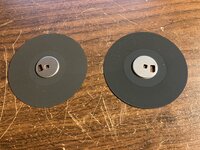
Closeup of a bad disk. You can see all the crud. I thought I had thoroughly cleaned this with 91% IPA. But it's clearly still all gunky. You can also see the circles where the head scraped.
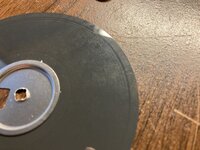
Closeup of a good one.
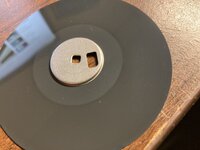
These were in someplace with very high moisture. Some of these disks are dated 1989, but the label peeled right off like it was new.

Closeup of a bad disk. You can see all the crud. I thought I had thoroughly cleaned this with 91% IPA. But it's clearly still all gunky. You can also see the circles where the head scraped.

Closeup of a good one.

These were in someplace with very high moisture. Some of these disks are dated 1989, but the label peeled right off like it was new.
olePigeon
Well-known member
Here's a closeup of a disk I had attempted to clean with a q-tip and 91% IPA. There was no saving these disks. Whatever is on these, it's on for good. I wonder if the magnetic stuff has separated from the plastic, and all the IPA does is wash it about without actually cleaning anything.
Out of curiosity, I'm going to try soap & warm water real quick.
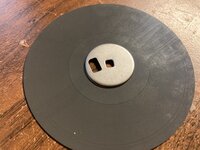
Out of curiosity, I'm going to try soap & warm water real quick.

olePigeon
Well-known member
Soap & warm water did much better, but there are still splotches here and there. These disks are unrecoverable. However, the soap & warm water has given me a little bit of hope for my floppy drives. I'm going to try cleaning them with warm water & soap, then a nice second clean with IPA. Maybe I can bring one or both back to life.
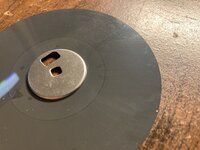

Johnnya101
Well-known member
I get mine from floppy disk.com or whatever the site is. Think I got the used 800k 50 pack last time. I'd trust them over other sites or places. The disks I got all seem to work and are all sony branded.I wouldn't bother trying them again, it's not worth the risk to damage more drives. I suspect this is what has happened to a lot of my drives, the ones that mechanically seem to work fine but just won't read disks properly no matter what.
Has anyone had a good experience with "new" floppy disks? Are there any that can be trusted?
olePigeon
Well-known member
Hazzah! I got both my drives working again. The soapy water took off dark black dots that had appeared after using the bad disks (not the black line, but some dark dots around it) on the top and bottom heads. I couldn't clean them off with IPA, so I assumed they were permanently damaged. But warm soapy water cleaned the dark dots off with just a few passes. Did a final clean with IPA. This was a successful experiment. Edit: I should have taken some before & after pictures of the black dots.
Phew!
Is there a reason not to use soapy water on the heads for general cleaning, followed up by IPA? I can understand perhaps soap film drying on it, but that's why I'd follow up with an IPA clean.
Phew!
Is there a reason not to use soapy water on the heads for general cleaning, followed up by IPA? I can understand perhaps soap film drying on it, but that's why I'd follow up with an IPA clean.
Similar threads
- Replies
- 3
- Views
- 531
- Replies
- 0
- Views
- 721
- Replies
- 45
- Views
- 2K

